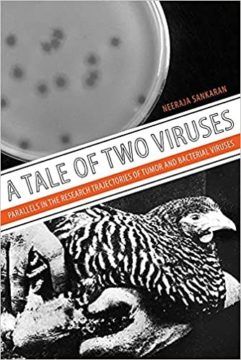Raghavendra Gadagkar in Inference:
 I SPENT THE SECOND HALF of the 1970s at the Indian Institute of Science in Bengaluru immersed in studying the lysogenic mycobacteriophage I3.1 One floor below my laboratory, a close friend, Arun Srivastava, was studying the Rous sarcoma virus (RSV).2 We were both fascinated by animal and bacterial viruses, and spent our spare time reading every publication we could find about λ, T4, ΦX174, rinderpest, and Newcastle disease. We came to believe that we knew nearly everything there was to know about them.
I SPENT THE SECOND HALF of the 1970s at the Indian Institute of Science in Bengaluru immersed in studying the lysogenic mycobacteriophage I3.1 One floor below my laboratory, a close friend, Arun Srivastava, was studying the Rous sarcoma virus (RSV).2 We were both fascinated by animal and bacterial viruses, and spent our spare time reading every publication we could find about λ, T4, ΦX174, rinderpest, and Newcastle disease. We came to believe that we knew nearly everything there was to know about them.
We were wrong.
In A Tale of Two Viruses, Neeraja Sankaran draws parallels between the stories of the bacteriophages, a group of viruses that infect bacteria, and RSV, which infects chickens. At first glance, this might seem an odd pairing for a work of comparative history. The two viruses behave very differently: phages induce lysis, which destroys bacterial cells, while RSV builds tumors. “[T]he pairing of these two viruses might seem rather arbitrary,” she writes, but “they have shared strangely parallel histories from the time of their respective discoveries in the early decades of the twentieth century until the early 1960s.”3
In 1910, Peyton Rous, an American pathologist working at Rockefeller University in New York, observed that a highly filtered sarcoma extract from one test subject—a chicken, of course—could induce a sarcoma in a second test subject. He concluded correctly that, given the size of his filters, whatever the substance inducing the sarcoma, it could not have been a bacterium. It was for this work that he won the Nobel Prize almost half a century later. In 1915, Frederick Twort, a medical researcher in London, arrived at a similar conclusion with respect to substances that seemed to infect bacteria; in 1917, Félix d’Hérelle, a self-taught scientist working at the Pasteur Institute in Paris, announced the discovery of “an invisible, antagonistic microbe of the dysentery bacillus.” Both men had discovered the bacteriophages.
More here.
